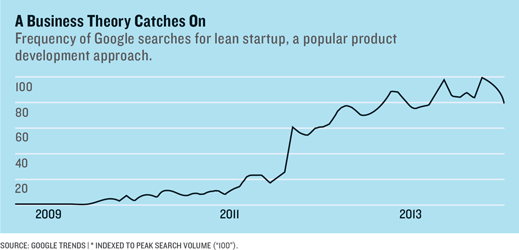Startups Embrace a Way to Fail Fast
Automated systems routinely make decisions required to trade securities, detect fraud, finger terrorists, and place ads on Web pages. But when it comes to developing these kinds of technology, the hottest decision-making system isn’t technological at all. It’s a product development philosophy known as the lean startup.
Formulated by a software engineer named Eric Ries, the lean startup method (or “methodology,” as its practitioners like to say) is a set of strategies designed to dispel the cloud of uncertainty around innovation. Ries realized that startups needed help in 2001, when he worked for a company that spent $50 million creating an online 3-D world only to learn that no one wanted to hang out in it. But how could any startup be sure it was building the next iPod, and not the next Zune?
Ries’s approach, synthesizing ideas from Japanese manufacturing, software development, and the scientific method, has proved to be catnip to Silicon Valley geeks. Ries’s 2011 book, The Lean Startup, became a best-seller, and awareness for his ideas “approaches 100 percent in entrepreneurial circles,” says Tom Eisenmann, who runs the entrepreneurship program at Harvard Business School. “A large fraction of teams think they’re following lean startup precepts whether they are or not.”
Among Ries’s promoters are Jeff Immelt, the CEO of General Electric, a company looking for ways to supercharge development of jet engines, power turbines, and refrigerators. Entrepreneurs from as far away as the United Arab Emirates and Beijing are also embracing the method as a kind of ready-mix formula for emulating Silicon Valley.
In Ries’s view, technology risk—the chance that a company can’t build what it sets out to build—isn’t the problem anymore. Market risk, on the other hand, is a killer. The problem is that businesses often conceptualize, design, and produce a product before they correctly gauge a market reaction. Ries’s method deconstructs these sorts of high-risk bets into a plethora of low-stakes gambles that can be tested on real-world customers. The idea is to run a series of experiments as quickly and inexpensively as possible, so that by the time you launch your product, you can be reasonably certain that customers will clamor for it.

An experiment can be as simple as interviewing a handful of potential customers loitering at the local shopping mall, or offering a “minimum viable product” with a tightly constrained feature set—sometimes the mere promise of capabilities that haven’t even been built.
While the approach can apply to any new business, the malleability of software lends itself particularly well to fast prototypes and turn-on-a-dime evolution. For instance, entrepreneur Paul Howe subjected his big idea for a Facebook app to the lean method a couple of years ago. His app, BlueSpark, would prompt users to record their purchases, then send a status update telling their friends. Those friends would then download the app, creating a viral sensation. Brilliant, right?
But first, Howe built a simple software script to test his idea on real users. He quickly ascertained that they were horrified. “Facebook used to be about sharing poetry!” one said. Howe dropped the idea. Two competitors, meanwhile, went on to spend millions building their own purchase-alert apps. Nine months later, they threw in the towel, citing hostile reactions. By that time, Howe had already moved on to his next idea.
Ries’s method encourages entrepreneurs to “fail fast” and quickly abandon ideas that aren’t working. Yet that may mean giving up too soon, skeptics such as investor Marc Andreessen have cautioned. Some of the most important products ever—like the Macintosh computer—came to exist against the odds and gained popularity only through perseverance and brilliant marketing.
Keep Reading
Most Popular
Large language models can do jaw-dropping things. But nobody knows exactly why.
And that's a problem. Figuring it out is one of the biggest scientific puzzles of our time and a crucial step towards controlling more powerful future models.
The problem with plug-in hybrids? Their drivers.
Plug-in hybrids are often sold as a transition to EVs, but new data from Europe shows we’re still underestimating the emissions they produce.
Google DeepMind’s new generative model makes Super Mario–like games from scratch
Genie learns how to control games by watching hours and hours of video. It could help train next-gen robots too.
How scientists traced a mysterious covid case back to six toilets
When wastewater surveillance turns into a hunt for a single infected individual, the ethics get tricky.
Stay connected
Get the latest updates from
MIT Technology Review
Discover special offers, top stories, upcoming events, and more.